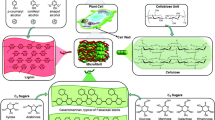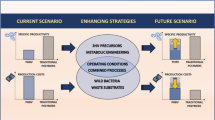Abstract
Direct production of ethyl levulinate (EL) from glucose catalysed by a liquid acid catalyst (sulfuric acid) and a solid acid zeolite catalyst USY NKF-7 (USY) in ethanol media was investigated in this study. Effects of the initial glucose concentration (C G0), reaction temperature (T), amount of acid catalyst, and water addition on the yields of EL were compared, respectively. The results show that higher yield of EL can be obtained at lower C G0. Higher temperature and acid concentration can accelerate the reaction rate, but the formation rate of the by-products increases more quickly than that of EL. Water addition also can result in the decrease of the yield of EL. Although sulfuric acid is efficient in the production of EL, the USY is more efficient in converting glucose to 5-ethoxymethyl-2-furaldehyde. Moreover, the use of USY can limit the diethyl ether production, and it can be reused for multiple times.
Similar content being viewed by others
References
Bozell, J. J., & Petersen, G. R. (2010). Technology development for the production of biobased products from biorefinery carbohydrates-the US Department of Energy’s “Top 10” revisited. Green Chemistry, 12, 539–554. DOI: 10.1039/b922014c.
Chang, C., Jiang, X. X., Zhang, T., & Li, B. (2012a). Effect of reaction parameters on the production of ethyl levulinate from glucose in ethanol. Advanced Materials Research, 512–515, 388–391. DOI: 10.4028/www.scientific.net/amr.512-515.388.
Chang, C., Xu, G., & Jiang, X. (2012b). Production of ethyl levulinate by direct conversion of wheat straw in ethanol media. Bioresource Technology, 121, 93–99. DOI: 10.1016/j.biortech.2012.06.105.
Chia, M., & Dumesic, J. A. (2011). Liquid-phase catalytic transfer hydrogenation and cyclization of levulinic acid and its esters to γ-valerolactone over metal oxide catalysts. Chemical Communications, 47, 12233–12235. DOI: 10.1039/c1cc14748j.
Dharne, S., & Bokade, V. V. (2011). Esterification of levulinic acid to n-butyl levulinate over heteropolyacid supported on acid-treated clay. Journal of Natural Gas Chemistry, 20, 18–24. DOI: 10.1016/s1003-9953(10)60147-8.
Fernandes, D. R., Rocha, A. S., Mai, E. F., Mota, C. J. A., & Teixeira da Silva, V. (2012). Levulinic acid esterification with ethanol to ethyl levulinate production over solid acid catalysts. Applied Catalysis A: General, 425-426, 199–204. DOI: 10.1016/j.apcata.2012.03.020.
Garves, K. (1988). Acid catalyzed degradation of cellulose in alcohols. Journal of Wood Chemistry and Technology, 8, 121–134. DOI: 10.1080/02773818808070674.
Gürbüz, E. I., Alonso, D. M., Bond, J. Q., & Dumesic, J. A. (2011). Reactive extraction of levulinate esters and conversion to γ-valerolactone for production of liquid fuels. Chem-SusChem, 4, 357–361 DOI: 10.1002/cssc.201000396.
Hu, X., Lievens, C., Larcher, A., & Li, C. Z. (2011). Reaction pathways of glucose during esterification: Effects of reaction parameters on the formation of humin type polymers. Bioresource Technology, 102, 10104–10113. DOI: 10.1016/j.biortech.2011.08.040.
Joshi, H., Moser, B. R., Toler, J., Smith, W. F., & Walker, T. (2011). Ethyl levulinate: A potential bio-based diluent for biodiesel which improves cold flow properties. Biomass and Bioenergy, 35, 3262–3266. DOI: 10.1016/j.biombioe.2011.04.020.
Lange, J. P., van de Graaf, W. D., & Haan, R. J. (2009). Conversion of furfuryl alcohol into ethyl levulinate using solid acid catalysts. ChemSusChem, 2, 437–441. DOI: 10.1002/cssc.200800216.
Lee, A., Chaibakhsh, N., Abdul Rahman, M. B., Basri, M., & Tejo, B. A. (2010). Optimized enzymatic synthesis of levulinate ester in solvent-free system. Industrial Crops and Products, 32, 246–251. DOI: 10.1016/j.indcrop.2010.04.022.
Le Van Mao, R., Zhao, Q., Dima, G., & Petraccone, D. (2011). New process for the acid-catalyzed conversion of cellulosic biomass (AC3B) into alkyl levulinates and other esters using a unique one-pot system of reaction and product extraction. Catalysis Letters, 141, 271–276. DOI: 10.1007/s10562-010-0493-y.
Mascal, M., & Nikitin, E. B. (2010a). Comment on processes for the direct conversion of cellulose or cellulosic biomass into levulinate esters. ChemSusChem, 3, 1349–1351. DOI: 10.1002/cssc.201000326.
Mascal, M., & Nikitin, E. B. (2010b). High-yield conversion of plant biomass into the key value-added feedstocks 5-(hydroxymethyl)furfural, levulinic acid, and levulinic esters via 5-(chloromethyl)furfural. Green Chemistry, 12, 370–373. DOI: 10.1039/b918922j.
Murat Sen, S., Henao, C. A., Braden, D. J., Dumesic, J. A., & Maravelias, C. T. (2012). Catalytic conversion of lignocellulosic biomass to fuels: Process development and technoeconomic evaluation. Chemical Engineering Science, 67, 57–67. DOI: 10.1016/j.ces.2011.07.022.
Olson, E. S., Kjelden, M. R., Schlag, A. J., & Sharma, R. K. (2001). Levulinate esters from biomass wastes. ACS Symposium Series, 784, 51–63. DOI: 10.1021/bk-2001-0784.ch005.
Peng, L., Lin, L., Li, H., & Yang, Q. (2011a). Conversion of carbohydrates biomass into levulinate esters using heterogeneous catalysts. Applied Energy, 88, 4590–4596. DOI: 10.1016/j.apenergy.2011.05.049.
Peng, L., Lin, L., Zhang, J., Shi, J., & Liu, S. (2011b). Solid acid catalyzed glucose conversion to ethyl levulinate. Applied Catalysis A: General, 397, 259–265. DOI: 10.1016/j.apcata.2011.03.008.
Peng, L., Lin, L., & Li, H. (2012). Extremely low sulfuric acid catalyst system for synthesis of methyl levulinate from glucose. Industrial Crops and Products, 40, 136–144. DOI: 10.1016/j.indcrop.2012.03.007.
Rataboul, F., & Essayem, N. (2011). Cellulose reactivity in supercritical methanol in the presence of solid acid catalysts: Direct synthesis of methyl-levulinate. Industrial & Engineering Chemistry Research, 50, 799–805. DOI: 10.1021/ie101616e.
Saravanamurugan, S., & Riisager, A. (2012). Solid acid catalysed formation of ethyl levulinate and ethyl glucopyranoside from mono- and disaccharides. Catalysis Communications, 17, 71–75. DOI: 10.1016/j.catcom.2011.10.001.
Author information
Authors and Affiliations
Corresponding author
Rights and permissions
About this article
Cite this article
Xu, GZ., Chang, C., Zhu, WN. et al. A comparative study on direct production of ethyl levulinate from glucose in ethanol media catalysed by different acid catalysts. Chem. Pap. 67, 1355–1363 (2013). https://doi.org/10.2478/s11696-013-0410-0
Received:
Revised:
Accepted:
Published:
Issue Date:
DOI: https://doi.org/10.2478/s11696-013-0410-0




